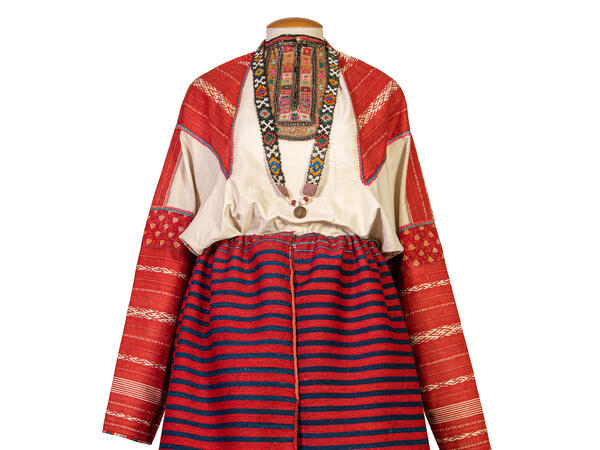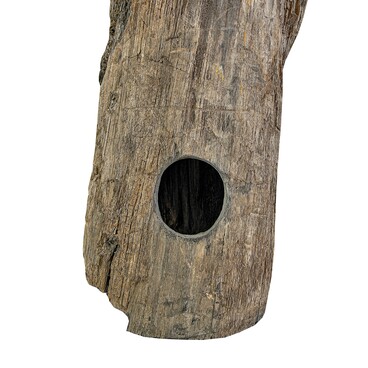The Sergiev Posad Museum-Reserve keeps one of the most complete collections of Russian traditional peasant clothing of the late 19th–early 20th centuries. Most of it was brought in the 1930s-2000s from scientific expeditions in the Russian North, the Volga Region, the Urals and South Russian territories.
One of the rare exhibits is a wedding outfit of the beginning of the 19th century. It was purchased from its creator Tatiana Shoshkina in the village of Vyazemka of the Zemetchinsky district of the Penza region during the expedition in 1981.
This outfit served as both a wedding dress and a festive costume of a young woman, which she wore before the birth of her first child. It consisted of a long-sleeve shirt, a poneva, a gaitan chest decoration, and a belt. Poneva was women’s waist clothing, vaguely similar to a skirt, for married women made of several pieces of fabric, which were fastened to the belt with a braided cord. Often the hem of the poneva could be richly decorated with patterned embroidery or weaving.
Swing ponevas made of three pieces, not sewn in front or on the side, were common on the territory of the Penza province for a long time. In the village of Vyazemka, a heavy swing poneva, woven on a hemp base with double thick woolen threads, was decorated with blue strips on a red background and a special border — “podolnik” at the bottom of the hem. The border pattern consisted of complex rhombic figures and wavy lines in white-blue-red colors scheme.
Poneva was worn over a long canvas shirt “dolgorukavka” with oblique shoulder inserts — poliki. The shirt retained the ancient length of the sleeves, which far exceeded the length of the arms. According to traditional beliefs, during the wedding, “in order to avoid witchcraft, the evil eye and other actions” that could harm the bride, her hands and other exposed parts of the body were carefully covered.
The shirt of the village of Vyazemka from the museum exposition is decorated not only with woven patterns, but also with strips of red patterned cotton chintz, braid, decorative seams along the edge of the hem and sleeves. The neck ornament — gaitan — is harmoniously combined with the chest decoration. It is made of two narrow strips, carefully woven from colored beads with a pattern of alternating oblique crosses and rhombuses. At the bottom, a cast double-sided copper icon with the image of the Mother of God and St. Nicholas is suspended from the gaitan.
One of the rare exhibits is a wedding outfit of the beginning of the 19th century. It was purchased from its creator Tatiana Shoshkina in the village of Vyazemka of the Zemetchinsky district of the Penza region during the expedition in 1981.
This outfit served as both a wedding dress and a festive costume of a young woman, which she wore before the birth of her first child. It consisted of a long-sleeve shirt, a poneva, a gaitan chest decoration, and a belt. Poneva was women’s waist clothing, vaguely similar to a skirt, for married women made of several pieces of fabric, which were fastened to the belt with a braided cord. Often the hem of the poneva could be richly decorated with patterned embroidery or weaving.
Swing ponevas made of three pieces, not sewn in front or on the side, were common on the territory of the Penza province for a long time. In the village of Vyazemka, a heavy swing poneva, woven on a hemp base with double thick woolen threads, was decorated with blue strips on a red background and a special border — “podolnik” at the bottom of the hem. The border pattern consisted of complex rhombic figures and wavy lines in white-blue-red colors scheme.
Poneva was worn over a long canvas shirt “dolgorukavka” with oblique shoulder inserts — poliki. The shirt retained the ancient length of the sleeves, which far exceeded the length of the arms. According to traditional beliefs, during the wedding, “in order to avoid witchcraft, the evil eye and other actions” that could harm the bride, her hands and other exposed parts of the body were carefully covered.
The shirt of the village of Vyazemka from the museum exposition is decorated not only with woven patterns, but also with strips of red patterned cotton chintz, braid, decorative seams along the edge of the hem and sleeves. The neck ornament — gaitan — is harmoniously combined with the chest decoration. It is made of two narrow strips, carefully woven from colored beads with a pattern of alternating oblique crosses and rhombuses. At the bottom, a cast double-sided copper icon with the image of the Mother of God and St. Nicholas is suspended from the gaitan.



